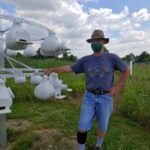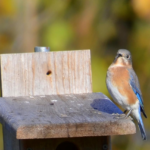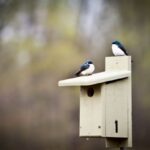By Saundra McBrearty, Outreach and Volunteer Specialist
and Paula Ziebarth, Delaware County Area Contact, Ohio Bluebird Society

We applaud Preservation Parks’ dedicated team of Nest Box Monitors who fulfilled the duties of citizen scientists by recording bird nesting activities. Volunteer monitors helped ensure the success of these birds and we extend a special “Thank You!” to: Dean Hard, Scott Lewis, Randy Morrison, Tom and Rosemary Domin, Paula Ziebarth, Renee Haas, Darlene Sillick, David & Serie Zimmerman, Judy Houston and Brink Kline for all their hard work this year. — Saundra
Preservation Parks of Delaware County has 91 nest boxes throughout the park district, 72 purple martin gourds at Gallant Farm and 36 at Deer Haven Park. Purple martins successfully fledged young from two of the gourds at the new rig at Deer Haven this year; the old rig had tree swallows take over and will be retired next year due to its location in successional habitat.
Nest box “trails” for native cavity nesting birds can be found at Blues Creek, Char-Mar, Deer Haven, Emily Traphagen, Gallant and Hogback Ridge Parks. In 2020, park trails fledged (young successfully left their nest box) 140 eastern bluebirds, 238 tree swallows, 170 purple martins, and 20 house wrens. This represents a record number of eastern bluebird fledglings for the parks. I attribute this to the unusual cold, wet spring weather that allowed eastern bluebirds to gain foothold over tree swallows early in the season. Like other swallows, purple martins suffered significant loss of ASY (after second year) adults that returned from their winter grounds and could not find enough flying insects to survive this spring. Both tree swallows and purple martins rebounded nicely once weather warmed up and flying insects became more abundant.

Eastern bluebirds, perhaps the most coveted cavity nester, remain in our area throughout the year. Delaware County residents can attract them to their yards by setting out a nest box for birds to raise their young. They are also attracted by feeding mealworms, sunflower hearts or crumbly suet mixes. Native berry producing plants are also an appreciated food source. These birds primarily eat ground dwelling insects during warmer months so nest boxes should be placed in short mowed grass areas to give them ample insect hunting opportunities for themselves and their young.

Tree swallows generally prefer to nest near a source of water, as water breeds flying insects, the major food source of these birds. The purple martin’s diet is comprised solely of flying insects and this bird prefer nesting near water as well. Purple martins will not nest near tall trees because they know such sites are unsafe due to marauding hawks and owls that use tall trees as hunting perches.
Those with wooded or brushy habitat can easily attract house wrens or carolina chickadees to nest with them.
Nest box placement and box design vary for these species. Correct installation, protection from predators, and management for competition from other bird species is important. Monitoring (or checking) nest boxes weekly is also important.
“Bluebirds Over Delaware” (BODE), is a bird conservation project for interested homeowners in Delaware County to set out nest boxes for native birds on their property. Participants must be willing to control non-native house sparrows which outcompete native species, check boxes weekly, and share data on nest outcomes. I enjoy helping people get started housing native cavity nesting birds and happy to advise anyone interested. To learn more or sign up for the project, please contact me at: paulazbird@gmail.com. — Paula






